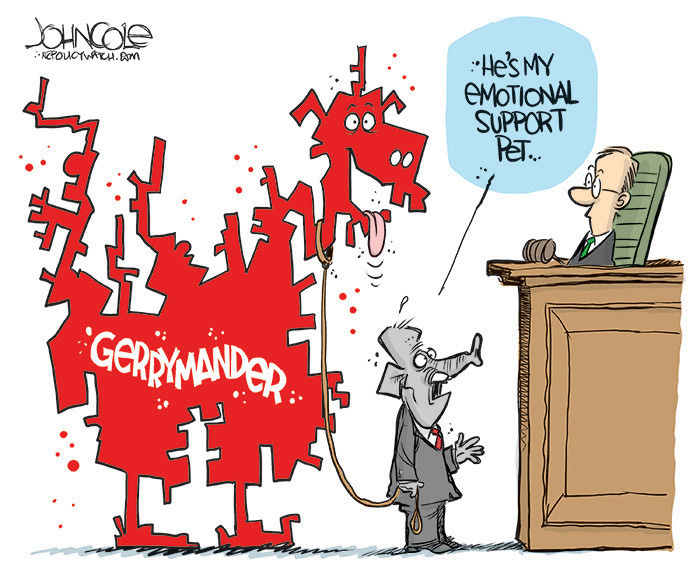The Red State-Blue State Divide: Gerrymandering Edition
“Just a simple redrawing, we pick up five seats!” Shazam!

Gerrymandering is a funny word that’s been around since 1812, when G. Elbridge Gerry, as Governor of Massachusetts, signed a bill creating a partisan district resembling a salamander. But gerrymandering efforts are no joke, having played a significant role in the distribution of American power since as early as 1788. Democrats and Republicans alike have benefited from partisan mapmaking in the centuries since, but Republicans have intensified the practice since the Reagan era, perfecting the art with the advancement of technology. Some states, like North Carolina, are now so blatantly gerrymandered that few districts are considered competitive— including areas once considered safe bets for Democrats.
With the 2026 midterm election cycle ramping up, Republicans are feeling anxious. From healthcare cuts to destabilizing tariff wars, the GOP’s deeply unpopular policies are generating dread and angering voters, including their own. So Republicans, realizing they can’t afford to lose any seats and lacking the support of their constituents, are looking for other ways to lock in victories.
And that’s where gerrymandering comes in.
Texas (where Republicans hold a razor-thin House majority) is a case in point. Rather than strategizing to win the support of constituents, legislators have planned a special session for today. The agenda includes mid-decade redistricting, in which they plan to racially gerrymander Black and Brown voting blocs. The unconstitutionality of doing so isn’t swaying Governor Abbott, who made the request following Trump’s thumbs-up to disenfranchising Texas voters.
Trump, speaking to reporters, said:
“There could be some other states we’re going to get another three or four or five in addition. Texas would be the biggest one. Just a simple redrawing, we pick up five seats!”
Democrats, for their part, may try breaking quorum to block the effort. The Buckeye State, where legislators are required to redraw maps in advance of the next election cycle, is another example. Republicans hope to gerrymander their way to a 2-seat pick-up there. In 2016, gerrymandering resulted in Republicans walking away with 75% of Ohio State Senate seats with only 50-60% of the votes. The Chronicle-Telegram Editorial Board wrote, “If you thought Ohio’s congressional districts were gerrymandered now, just wait until Republicans get through with redistricting for the 2026 election!”
This week, the Florida Supreme Court ruled to uphold their current congressional map, dismissing a challenge lodged over the elimination of a majority-Black district through gerrymandering. That means, going into 2026, Republicans will have a 20-8 advantage over Democrats!
Gerrymandering is the Republicans’ favorite game. By rigging the vote, they’re “winning,” and they aren’t slowing down any time soon!
But How Does Gerrymandering Work?
Partisan gerrymandering is accomplished through two intertwined tactics – packing and cracking. Packing is the consolidation of people into denser, but fewer districts by characteristic— typically party affiliation, race, or ethnicity. When legislators use packing to draw a district, they’re essentially conceding that consolidated district to their rivals. At the same time, they’re strengthening their own voter blocs in remaining districts.
Cracking is the splitting of voter groups between districts (again, by characteristic), for the purpose of weakening the overall power of those groups at the ballot box… But there’s a catch! Cracking is risky for mapmakers, because it dilutes the power of their own voters. The more aggressive the gerrymander, the less confident they can be when election day rolls around. Minority Leader Jeffries was right when he said, “Republicans are cutting off their nose[s] to spite their face[s] when toying with the maps!”
Racial gerrymanders result in oddly shaped districts. They confound voters and are often challenged in court. But the judicial system, time and time again, has proven too slow (or too corrupt) to keep up.
Gerrymandering favors hyper-partisanship, locking in the majority party’s rule, while silencing the voices of the minority party. For these reasons, there’s been a push — at times bipartisan — to end the practice once and for all. Activists for fair maps support the use of independent, nonpartisan redistricting commissions, such as those used in Michigan, Arizona, and Colorado.
“Hold on there! Gerrymandering Has No Effect on State-wide or Presidential Election!”
Actually… While it’s true voters can’t be disenfranchised by redistricting alone when it comes to choosing a Governor or a President, long-term gerrymandering creates apathy and distrust in the election process itself. Voters in duck, snake, and octopus-shaped districts often feel their votes – their voices - don’t matter. So, they opt out of civic engagement altogether. Another side effect? Lazy legislators!
Making matters worse, those who gerrymander rarely stop there. To further ensure the outcome of races and suppress votes, they (usually Republicans) purge voter rolls, eliminate polling locations, and pass strict voter ID laws - using talking points rooted in dishonesty.
In March, Trump issued an Executive Order with an Orwellian name: Preserving and Protecting the Integrity of American Elections. It’s a shameful voter ID measure that would require the decertification of previously certified voting machines, give DOGE and DHS access to voter records, and unravel the promise of a democratically elected government. Given how disproportionately it would impact people of color, low-income voters, and Indigenous Americans, Republicans should have called it the “Show Me Your Papers” Order!
The above EO, which violates both the Constitution and federal law, is being legally challenged. But no matter the outcome of those lawsuits, the Order stands as a reminder of what’s at stake: With Trump Republicans in power, our right to vote (and have our votes counted) is in peril!
Call To Action
Support organizations that are leading the fight for fair maps and election processes, such as:
“[O]n a mission to end gerrymandering… It’s time to end map manipulation and finally have fair districts.”
The Brennan Center for Justice
The “leading the campaign for fair maps and urgent reforms.”
Like, share, and restack this post so that others understand the threat of gerrymandered districts!






